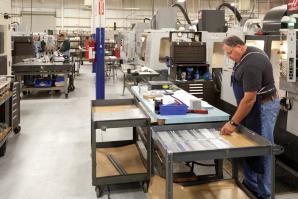Congratulations Sacramento. You finally got the economic recovery you’ve been asking for.
It’s not as big or fast as you had wished for, but give it time. It should get stronger as we move toward 2014.
Forecasters don’t always measure the same things in the same ways or peer the same distance into the future, but they agree the recovery will keep a slow pace for 2013.
Sacramento’s Center for Strategic Economic Research, affiliated with the Sacramento Area Commerce and Trade Organization, sees job growth hitting an annualized 2.6 percent by the third quarter. That’s a big improvement when you consider it took until March of 2012 just to crawl out of negative territory.
The upward trend includes notable anticipated turnarounds for construction, financial activities and leisure and hospitality.
But that’s not enough to catch up to pre-recession levels. The Sacramento center projects nonfarm employment to reach 875,000 by September for the six-county region it tracks. That’s no higher than it was in 2002 and still 79,000 jobs below the peak of June 2007.
Jeffrey Michael is even less optimistic. The director of the Business Forecasting Center at the University of the Pacific in Stockton sees job growth coming in at less than 2 percent for the year.
“Our outlook is not for any substantial acceleration in the pace of job growth in the Sacramento and Stockton areas in 2013 from the 2012 pace,” he says.
Through the slow recovery, health care has been a consistently solid area of job growth, and the government sector has the potential for revival.
“It will be interesting to see how things develop in the post-Prop. 30, supermajority world,” Michael says. “I don’t think it’s necessarily a windfall for Sacramento, but there could be a little relief on that part of the Sacramento economy. We expect the furloughs will eventually go away in the next fiscal year. It will put a little more money in the pockets of a large share of the Sacramento workforce.”
Moody’s Analytics has Sacramento’s unemployment rate dipping below 10 percent by the end of the year, offering at least a psychological boost. By contrast, the Gary Anderson Center for Economic Research at Chapman University in Orange predicts a 7.5 percent national unemployment rate.
Two factors are holding Sacramento back from meeting the national average.
“One of the reasons it is going so slow is that you are going to see the shrinkage in the labor force finally stopping,” said Eduardo Martinez, senior economist with Moody’s. That is, people who had given up on finding work during the recession will see the improving jobs picture and start hunting again. And people will continue to move into the area because of its relative cost advantages over the Bay Area.
A bigger story to watch in 2013 is how much momentum the fledgling real estate recovery acquires, Michael says.
“You may see 50 percent increases in housing starts, but those growth rates become kind of meaningless when you are sitting in a trough,” he says. Inventory is falling, setting the stage for price growth.
“Most of the pipeline of really distressed product has been flushed out,” Martinez says.
Additionally, investors have shown a lot of interest, especially at or below the median price. That has put a floor under the market.
“That makes sense to me because I think residential real estate in the region has been underpriced,” Michael says. “Our belief is that the housing market was about 20 percent underpriced at the trough.”
The investors entering the local market aren’t just flippers. Many have been buying to rent.
“I think what we have seen is a wide array of investors, from small local investor to large institutional investors and even hedge funds. That is something that has really happened over the past year,” he says.
With demand coming back, supply will follow. The Business Forecasting Center sees single-family housing starts in the region going from about 3,000 in 2012 to about 4,500 for the new year. Again, it’s a question of how one looks at the numbers. It’s 50 percent growth, but still only a shadow of pre-recession activity.
On the commercial side of real estate, Sacramento may be in the path of progress again.
“As you look down toward the Stockton area, the transportation and distribution area continues to be a strong growth sector,” Michael says. One recent manifestation is online retailing giant Amazon announcing late in 2012 that it would be building a distribution center in Tracy.
Martinez notes that Bay Area back-office space is already migrating to the East Bay.
“As the East Bay starts to price up, it puts Sacramento in a pretty good position,” he says.
With jobs and real estate showing some renewed life, there should be more money to spend at area stores and restaurants.
“The retail sector has perked up quite a bit. That was one of the stories of 2012,” Michael says. But there are also a few things that could pull money back out of peoples’ pockets before they walk into any stores.
“At the margins, we don’t know what is going to happen with this fiscal cliff thing,” Michaels said in December, “and we have a lot of sales tax increase in Sacramento and statewide. They are all small, but you put them all together and they reduce disposable income.”
California is really going through a two-track recovery, according to Jerry Nickelsburg, senior economist at the UCLA Anderson School of Management. The Bay Area is growing at twice the pace of national employment growth, while the inland counties are still struggling. That makes it hard to discern much from statewide numbers.
Numbers aside, the only thing many people want to know is when the local economy will get back to normal.
“I don’t know what normal is,” Michael says. “By some measures, maybe another three or four years. By other measures, it may be a decade.”
What’s Next?
The Next Economy initiative debuts its plan this month
When the recession wiped out more than 110,000 jobs in the Sacramento area, a number of groups and individuals looked to regional jobs initiatives as a way out of the hole.
The Next Economy initiative launched in 2011 with the backing of Valley Vision, the Sacramento Metro Chamber, the Sacramento Area Commerce and Trade Organization and the Sacramento Regional Technology Alliance. It aims to create jobs by looking at economic clusters rather than individual industries. That is, the jobs effort would address the entire ecosystem around an industry, including the related suppliers, support businesses and institutions.
Seven clusters have been targeted: advanced manufacturing, agriculture and food, clean energy technology, education, information and communications technology, knowledge-intensive business and financial services, and life science and health services.
An implementation plan is slated for its public debut at the end of January. Even then, it may not be fully formed, says Christine Ault, a project manager at Valley Vision.
“But we have been writing and planning so long, the leaders have come to the decision that we don’t want to wait,” she says. “We feel we have enough activity defined that it makes sense to hold ourselves to that deadline.”
A 23-page working draft divides the tasks into five sections:
-
Foster a strong innovative environment
-
Amplify the region’s global market transactions
-
Diversify the economy through growth and support of core business clusters
-
Grow and maintain a world-class talent base
-
Improve the regional business climate for economic growth
Each of the five tasks has a “champion” organization to coordinate the effort. Each section also is broken down into highly detailed actions, about 300 in all. In draft form, however, many of those actions involve more research, more evaluation, more strategizing.
As an example, which may be altered by the time the final plan is out, UC Davis and California State University Sacramento are to champion better commercialization of university research.
“We know UC Davis has the capacity for technology transfer, but not necessarily the best structure” Ault says. “Entrepreneurs don’t’ know how to get through the system.”
The task list, then, includes establishing a “front door” at the schools and creating or expanding units to support startups.
Even at that, the implementation plan doesn’t try to cover everything, Ault says. It tries to avoid duplicating efforts other organizations are already covering.
“A lot of it is gap-filling; areas where we are doing well, but not as well as we could,” Ault says.
The objectives are supposed to have performance measures so that successes can be quantified.
That, too, is a work in progress.
Recommended For You

The Auburn Advantage
How one city turned lifestyle into business leads
Downtown Auburn has a distinct, modern-day Mayberry feel, from the stone-paved sidewalks to the rustic brick bus stop. But five miles away,




